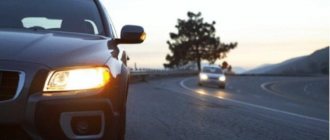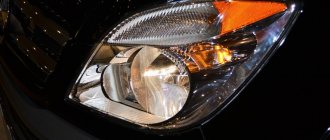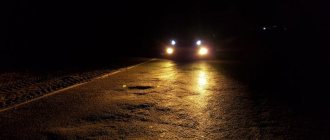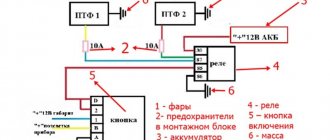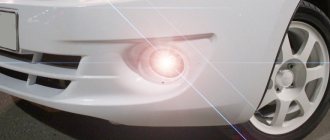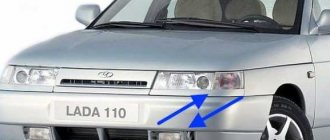Traffic rules for the use of lighting equipment
The use of automotive lighting equipment is regulated not only by the Traffic Rules, but also by the “Basic Provisions for the Admission of Vehicles,” as well as GOST 33997-2016, which replaced the canceled GOST R 51709-2001. The new standard, unlike the old one, only regulates the installation of additional lighting devices, leaving the availability of the main ones to the discretion of the developers. Also, general vehicle safety information is regulated in the Technical Regulations TR CU 018/2011.
Dimensions
In accordance with Section 19 of the Traffic Regulations, the driver must turn on the side lights if he has stopped or parked in conditions of limited visibility. When driving, the rules require turning on the dimensions only on trailers .
Structurally, the side lights at the rear and front of a wheeled vehicle (VV) must be turned on from one control, and the voltage supply to the rear license plate lights must also be combined with it. In practice, the same switch also lights the low beam headlights. This point is not regulated by the rules, but GOST has a clause that states that such a combination is mandatory. The standard also prescribes the inclusion of side lights when the vehicle's dashboard lights are turned on, but this requirement is not strictly stated.
Activated vehicle tail light.
Without igniting the side lights, the low or high beam lights can only be turned on to provide short-term signals by flashing or quickly switching between low and high beams. Rear dimensions should not be red, and front ones should not be white . This applies to all light-emitting devices in the vehicle, both basic and optional. The last category includes:
- spotlights;
- searchlights;
- emergency stop lights.
GOST also includes other lighting equipment in this concept.
What do the traffic regulations say about running lights?
According to the 2016 Road Traffic Regulations, all drivers must turn on DRLs or fog lights or low beam lights while driving. Such requirements ensure the safety of all other road users.
If the driver does not comply with this rule, he may be issued a fine of 500 rubles.
According to the traffic rules, DRLs must be used in the following cases:
- If minor passengers are transported;
- If transport is difficult to distinguish in the distance;
- If oversized items or harmful substances are transported;
- DRLs must be used on public transport and minibuses.
When can you use fog lights?
The use of these external lighting lamps is clearly regulated by the traffic rules clause “fog lights” (clause 19.4). The driver must turn them on when driving:
- in difficult weather conditions or after sunset in combination with the headlights turned on in low or high beam mode;
- as daytime running lights instead of the low beam system.
Fog lights installed on the rear of the vehicle can only be turned on in conditions of limited visibility.
A car with the front fog lights on.
It is not allowed to use rear fog lights in combination with brake lights. Their design provides a brighter glow than the front ones. When braking, this can lead to blinding of the driver who is driving behind in the same direction.
Adjust the fog lights in accordance with the vehicle manufacturer's instructions. If there are no instructions, the standards of GOST 33997-2016 are applied when adjusting. The glow color should be white or orange.
Lada 2107 › Logbook › Automatic switching on of low beam headlights after starting the engine.
After the last car (Subaru Forester SF5), in which the headlights turned on and off when the engine was started, I had to get used to pressing the button every time before starting to drive. In just over a month of owning the 7, there have already been times when I forgot to turn on the headlights, fortunately I didn’t get a fine. It was decided to make minor modifications to the car to automate the inclusion of low beam headlights. There are quite a lot of different options on the Internet for obtaining this effect, both homemade and factory-made buns. Since it’s more interesting to do everything yourself, I decided to assemble a simple circuit using relays. For myself, I decided that my light should turn on only after the engine starts, not to disrupt the operation of the standard circuit, and so that when I turn on the light through the standard button, my “circuit” should be disassembled. To implement this task, the following were purchased: 1) 4-pin relay - 1 piece 2) 5-pin relay - 2 pieces 3) 4-pin relay block. — 1 piece 4) relay block 5 contacts. - 2 pcs. 5) holder for a fork fuse 6) wires, corrugation, electrical tape Most likely there will be those who will say that it could have been done simpler, that three relays are a lot and could have been connected differently, but for me the circuit I came up with is simpler and more convenient. Naturally, I do not claim that this is how this modification should be carried out) The principle of operation and the role of each relay. 1) The first relay is connected with contact 30 through a fuse to the battery. One contact of the coil is to ground, the other is to the 15th contact of the ignition switch, the 87th contact is connected to the 30th contact of the second relay. 2) The second relay has a 30th contact, as already written above for the first relay, one coil contact to the 15th contact of the ignition switch, the second end of the coil to the oil pressure sensor. Contact 87A is connected to the 30th contact of the third relay. 87 The second relay contact is not connected to anything. 3) The third relay with the 30th contact to contact 87A of the second relay, one coil contact to ground, the second to 12V from the size. Contact 87A is connected to the standard relay for turning on the low beam headlights, namely to contact 85 (if I’m not mistaken).
As a result, after turning the key to the “ignition” position, the first relay transmits voltage from the battery to the second relay. The second relay, while the engine is not started and there is ground on the oil pressure sensor, opens contacts 30 and 87A, thereby not passing 12V to the 30th contact of the third relay. After starting the engine and increasing the oil pressure, the ground on the oil pressure sensor disappears and contacts 30 and 87A of the second relay close again. The third relay transmits voltage to the standard low beam headlight relay until the low beam headlights are switched on using a standard button, which in the first position supplies 12V to the dimensions, as a result of which the third relay opens contacts 30 and 87A.
When connecting to a standard relay, I decided to put a diode in the gap of the standard wire, which I took from an old PC power supply. Maybe it was unnecessary, but it makes me feel better =D
Connection points. 1) 15th contact of the ignition switch, on which 12V appears when the key is turned to the “ignition” position. Blue wire (double thicker and thinner). 2) Oil pressure sensor. The connection to it was made in the engine compartment. 3) Connection to 12V dimensions. For the left headlight, this is a yellow wire going to the headlight unit in the engine compartment, directly next to the headlight unit itself. 4) Connection to the standard low beam headlight relay. Gray wire with a red stripe Block Ш1 (black) going to the fuse and relay block under the hood. You can only gain access to this wire from the interior by disassembling the control panel.
What lights should you use to drive during the day according to traffic rules?
In this regard, the Rules do not allow for discrepancies. During the day, you should drive with your headlights on low beam or daytime running lights (DRL). White fog lights or separate lights can also be used as DRLs.
Standard car DRLs.
| Lighting equipment | Use as DRL |
| Driving lights | Forbidden |
| Low beam lights | Allowed |
| White front fog lights | Allowed |
| Orange front fog lights | Forbidden |
| Rear fog lights | Forbidden |
| Turn signals | Forbidden |
| Dimensions | Forbidden |
| License plate lamp (rear) | Forbidden |
| Separate DRLs provided for by the design of the car or additionally installed and registered with the traffic police, as changes to the design | Allowed |
DRL must be turned on regardless of the driving area - inside a populated area or outside the city.
How to choose DRL?
The requirements that must be taken into account when installing DRLs have already been described above.
If the running lights on your car are not installed correctly, the traffic police inspector will have the right to stop you and issue you a fine. In some situations, the vehicle may even be sent to an impound lot.
If you want your running lights to comply with traffic rules and GOST, you should pay special attention to their selection. After all, a lot will depend on what kind of road running light you decide to install on your car. The highest quality products are produced by companies such as Hella and Philips Osram. It is worth choosing them not only because they meet all the standards, but also because they can make your journey on the roads as safe as possible. There are usually no problems with the products of the brands presented above when the car is diagnosed at a service station. Homemade devices cannot meet all requirements.
Usually there are no difficulties with installing DRLs. The only thing that can cause you inconvenience is a violation of the integrity of the car’s structure. This problem is most common among drivers who bought their car before the law on the mandatory use of DRLs came into force.
If you have an old car that does not have DRLs, then you will have to collect a lot of paperwork to obtain permission to make changes to the vehicle. In addition, you will also have to put in a lot of effort to install running lights. After all, to do this you will have to create holes in the bumper and deal with the electronics.
Hotlines:
Moscow:
+7, ext. 206 St. Petersburg: +7, ext. 997 Regions of the Russian Federation: +7, ext.
669 .
Applications are accepted around the clock, every day. Or use the online form.
Which headlights should you use depending on the situation?
The driver turns on other standard lighting devices independently, depending on actual conditions. Their use in different situations is also regulated by traffic rules.
In case of insufficient visibility
In poor visibility conditions, the Rules require the driver to activate:
- on wheeled vehicles - headlights in low or high beam mode;
- on bicycles - headlights or lanterns.
Horse-drawn carts may have lights, but traffic regulations do not require their installation.
In good visibility
In case of good visibility and simple weather conditions during the day, the use of lighting equipment is reduced to the use of headlights in low beam or DRL mode.
Traffic in the tunnel
Driving through the tunnel is equivalent to driving after sunset or in conditions of limited visibility. Therefore, the driver is required to turn on the headlights or lights, depending on the type of vehicle. Trailers in the tunnel must have side lights activated .
Driving in a tunnel must be done with the lighting equipment turned on.
Driving in the dark
The use of lighting equipment after sunset is regulated by the same paragraph 19.4 of the traffic rules. The driver must turn on the headlights in high or low mode, and in their absence, turn on the flashlights. Paragraph 19.4 allows the use of fog lights at night in conjunction with conventional headlights, even in conditions of limited visibility.
Optional devices such as a spotlight and a searchlight are permitted by traffic regulations to be used outside populated areas only when there are no other cars on the road. Otherwise, the risk of blinding is extremely high, since they emit light in a narrow cone. Exceptions include vehicles of special services and in special cases. Unauthorized installation of such equipment is also prohibited.
Driving with faulty equipment is not permitted.
And most importantly, in accordance with the mentioned GOST, lighting equipment must be in good working order, and the basic provisions prohibit driving with non-working light-emitting devices and even with unadjusted headlights. The driver must monitor the condition of the devices, thereby increasing traffic safety for himself and other car owners.
There is a solution: what to do and how to punish those who like to blind
In theory and following the rules of the road, it would be correct to press the emergency button, reduce speed and stop. Okay, how can you do it quickly if you can't see anything? We can advise you to develop a reflex to find this button with your eyes closed. It actually helps if you practice beforehand. This training will be useful in order to slow down and brake without looking, without causing harm to your health.
The main thing is not to panic! This is possible, of course, only if you have sufficient driving experience and strong nerves. It is important not to jerk the steering wheel and behave calmly. Especially, it is not recommended to try to press against the side of the road “by touch”. Such maneuvers will not lead to anything good.
Learn to quickly look away when you see an oncoming car with high beams. This will help to avoid getting disoriented. You can also close one eye and watch the road with the other. In the case of approaching vehicles with high beams, do the opposite, opening the eye that was closed. This way it will be possible to restore blinded vision. Although, all this is difficult to do at the moment when sudden blindness occurs.
There is a good way to protect your eyes - night glasses. They are equipped with a special filter that prevents glare and protects from daylight and light surges.
The Chinese came up with an interesting method to help fight those who like to cuddle on the highway, blinding them with high beam headlights.
A cunning, one might say unique weapon is used! These are stickers that are glued to the windshield of a car. During the day, in the evening and at night, these objects do not attract attention. If the driver turns on the high beams, a shiver will immediately go through his entire body.
The police, of course, responded to this by stating that the use of such stickers is not prohibited by law. Only if an emergency situation arises because of this, you will have to answer to the court for such actions. These horror stories cost from three to twenty dollars.
Is it necessary to pay the offender in the same coin? Sometimes, some people want to respond back by blinding them with high beams. But is it worth stooping to the level of a boor?

